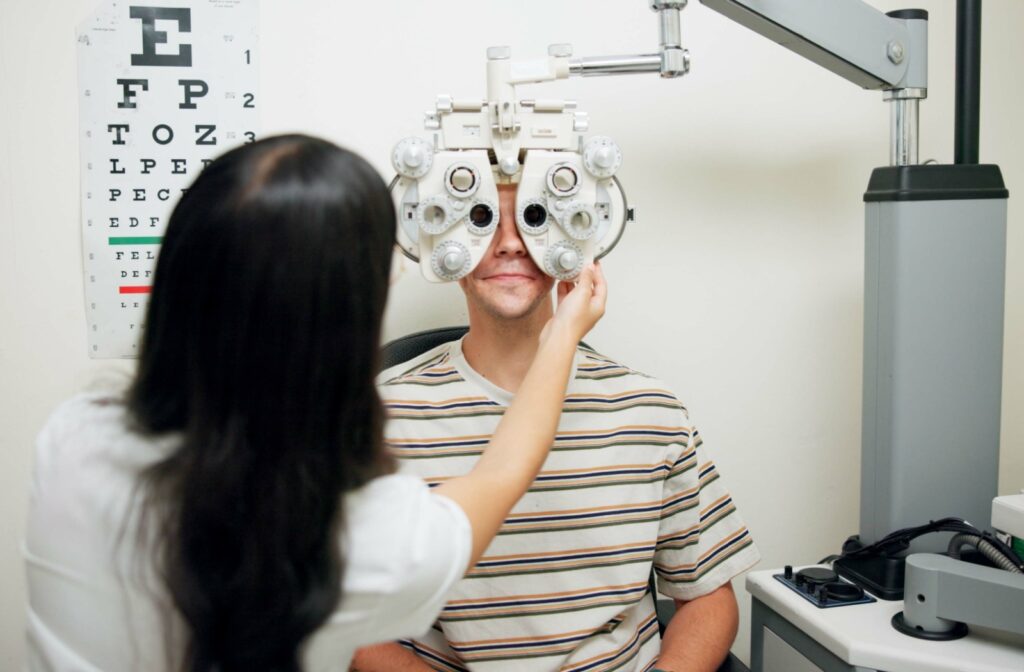You probably think an eye exam is just for checking your vision. However, a comprehensive eye exam does much more—it can also offer a view of your overall health. Your eyes can show early signs of certain health conditions before you begin to notice symptoms.
A routine eye exam in Kansas City is a simple, proactive step to protect both your sight and your well-being. Your yearly check-up can help detect a wide range of eye diseases and even systemic health issues that affect your entire body.
Eye Diseases That An Exam Can Identify
Some of the most common vision-threatening conditions can develop without obvious symptoms. Fortunately, with an eye exam, we can identify issues early, allowing you to manage these conditions and support your long-term eye health.
Age-Related Macular Degeneration (AMD)
This condition affects your central vision, which you use for detailed tasks like reading and driving. An eye exam can spot early signs of AMD. Early detection allows for management strategies that can help preserve your sight.
Glaucoma
Often called the “silent thief of sight,” glaucoma damages the optic nerve, usually without early warning signs. We check your eye pressure and examine your optic nerve to catch glaucoma before significant vision loss occurs.
Cataracts
A cataract is a clouding of the eye’s lens that can make your vision blurry, hazy, or less colorful. During your exam, we can assess the development of cataracts. From there, we can discuss your options for clear vision.
How Systemic Diseases Appear In Your Eyes

Your eyes are filled with tiny blood vessels and nerves that reflect the health of your entire body. Here are some of the general health issues that a comprehensive eye exam can reveal:
Diabetes
Diabetic retinopathy is a condition caused by damage to the blood vessels in the retina. During your exam, we look for potential signs of this disease, including leaky blood vessels and swelling. Managing this condition is a team effort to protect your vision.
High Blood Pressure
Your eye doctor can see signs of high blood pressure by looking at the blood vessels in the back of your eye. Telltale signs are bends or kinks in vessels and bleeding in the retina. This gives you valuable information to share with your primary care provider.
High Cholesterol
Cholesterol deposits can appear in your eyes, sometimes before you’re aware of the issue. An optometrist may notice a yellow or blue ring around the cornea. We might also see plaque within the retinal blood vessels.
Can An Eye Exam Detect Brain & Nerve Issues?
Because the optic nerve is a direct extension of the brain, an eye exam can reveal important information about your neurological health.
Increased Brain Pressure
Pressure inside the skull can cause the optic nerve to swell, which we can see during an exam. This could point to conditions that need further medical attention.
Stroke Risk
Blockages or clots in the small blood vessels of the retina can sometimes indicate an increased risk for a stroke. A loss of side vision may also be a sign of brain changes from a past stroke. This information can help you and your other doctors make informed decisions.
Multiple Sclerosis (MS)
Inflammation of the optic nerve can be an early indicator of MS. This condition often comes with blurry vision or pain when you move your eyes. An eye exam can help identify these signs.
Inflammatory & Autoimmune Conditions Spotted In The Eye
Many autoimmune diseases cause inflammation throughout the body, and the eyes are often affected. An eye exam can help spot these signs.
Rheumatoid Arthritis & Lupus
These conditions can cause inflammation in the white part of the eye, a condition known as scleritis. They are also frequently linked to uncomfortable dry eye symptoms. We can help you find ways to manage this discomfort.
Sjögren’s Syndrome
A key feature of this autoimmune disease is severe dry eye. If you experience constant burning, stinging, or gritty feelings, it’s worth getting your eyes checked out. Our practice offers dry eye services like OptiLight to help manage these symptoms.
Thyroid Disease
Graves’ disease, a common thyroid condition, can cause the eyes to appear larger or bulge. It is also associated with dry eye and changes in vision. We can address these symptoms as part of your eye care plan.
What About Your Child’s Eye Health?
Regular eye exams are just as important for children as they are for adults. An early eye exam is a great way to give them a strong start.
Amblyopia (Lazy Eye)
This condition occurs when one eye doesn’t develop proper sight. It’s a common cause of vision loss in children. The condition can be managed effectively if found early through a comprehensive exam.
Myopia (Nearsightedness)
If your child’s distance vision seems to get worse each year, it may be progressive myopia. Our myopia control programs are designed to help slow this progression. This approach promotes better long-term eye health for your child.
Your Next Step For A Healthy Outlook
Your eyes tell a story about your total health. Scheduling a regular comprehensive exam is a great way to get a good picture of your health.
Whether you need a routine check-up, have concerns about dry eye, or want to explore myopia control for your child, we are here to help. At Littlefield Eye Associates, we aim to make you feel comfortable while providing quality care. Schedule your appointment to take a proactive step for your health.





